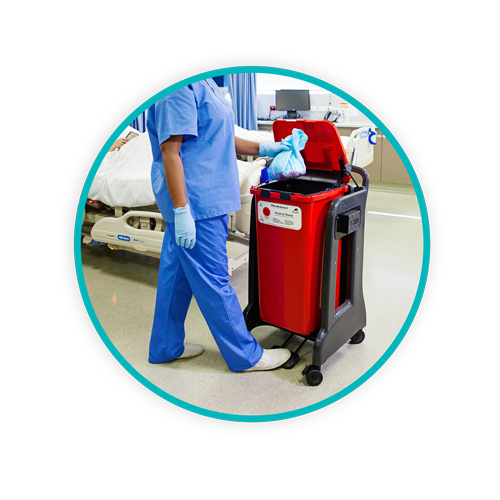What is Hospital Medical Waste?

Hospital medical waste disposal is one of the most important functions of any medical facility. Failure to properly handle and dispose of medical waste can cause environmental hazards and even widespread illness.
TOPICS WE WILL COVER
1 / What is Hospital Medical Waste and What Are the Categories of Hospital Waste?
2 / Why Understanding Hospital Medical Waste is an Essential Part of Responsible Medical Practice
What Kind of Waste Is Hospital Medical Waste?
What is most often considered hospital medical waste is any refuse generated during normal hospital operations.
While the waste generated from a clothing retailer or a restaurant (for example) can be handled through normal municipal waste collection channels, hospital medical waste must be handled and disposed of in a very regulated manner to ensure clinicians, hospital staff and downstream service staff aren’t exposed to potentially hazardous contaminants.
EPA Definition
The Environmental Protection Agency (EPA) defines hospital medical waste in the following terms:
“All waste materials generated at healthcare facilities, such as hospitals, clinics, physician’s offices, dental practices, blood banks, and veterinary hospitals/clinics, as well as medical research facilities and laboratories.”
However, there are important sub-categories as well. Because hospitals offer a diverse scope of medical processes, testing, and— in some cases—pharmaceutical compounding, there are multiple classifications of medical waste that require different handling, transportation, and disposal methods. Here are some key hospital medical waste classifications that demand specific disposal protocols.
Hospital Medical Waste Classifications
1. Infectious/Biohazard Waste
This category is also commonly known as biohazardous waste. This is waste that could potentially cause the spread of infection/infectious diseases and includes anything that has been exposed to bodily fluids and tissue, either human or animal.
This includes exposure to body fluids such as blood, cells, bandages, sample flasks and containers, swabs, and all non-reusable items contaminated by potentially infectious agents. Infectious waste can increase the threat of the spread of pathogens, requiring scrupulous care in the disposal of biohazardous waste.
2. Hazardous Waste
Hazardous waste is waste that poses a threat of harm either through pollution, poisoning, or injury and is therefore considered dangerous.
These hazardous materials include chemical wastes such as solvents and old surgical and examination tools. Though this category of waste does not include materials that could cause harm through infection, it does have the potential to cause significant harm to people and the environment.
Hazardous waste is regulated via the Resource Conservation and Recovery Act (RCRA), so as a result, in hospitals, most hazardous substances fall under the categorization RCRA Hazardous.
3. Radioactive Waste
Numerous diseases are diagnosed and treated using radiology. Cancer therapies use radioactive treatments, and even basic diagnostic technologies like x-rays, mammography, positron emission tomography (PET), and fluoroscopy use radiation.
The byproducts that have been exposed to nuclear isotopes are classified as radioactive waste. This waste, if handled and disposed of improperly, could pose widespread health risks. It is worth noting that radioactive waste is generally considered to be a subset of hazardous waste as defined by RCRA.
4. General Waste
Medical settings produce general waste, similar to typical office or domestic waste. However, because of its proximity to hazardous, biohazardous, and radioactive waste, it must be handled very carefully, as contamination can occur. This waste category includes paper products, disposable plastics, and food waste.
5. Pathological Waste
Pathological waste in a hospital refers to biological materials and specimens from medical procedures, surgeries, or autopsies.
This includes tissues, organs, human body parts, and fluids removed or biopsied for diagnosis, treatment, or research, as well as non-human animal carcasses. Proper pathological disposal is crucial to prevent infection and ensure safety in healthcare facilities.
6. Cytotoxic Waste
Cytotoxic waste refers to hazardous materials contaminated with cytotoxic drugs used in cancer treatment. This waste includes used syringes, drug containers, protective gear, and other items that pose risks to human health and the environment. Proper handling and disposal procedures are crucial to prevent exposure and contamination.
7. Pharmaceutical Waste
Pharmaceutical waste in a hospital setting refers to expired, unused, or contaminated medications, as well as associated materials like packaging, that need safe disposal. It includes drugs, chemicals, and biological substances that may pose health and environmental risks if not managed properly. Hospitals follow strict protocols for pharmaceutical waste disposal to ensure safety and compliance.
Understanding Hospital Medical Waste: An Essential Part of Responsible Medical Practices
While medical settings have clear-cut biohazardous medical refuse like sharps waste, blood, and cell matter that require careful disposal, it might still be mistakenly handled improperly during busy periods.
The Importance of Proper Hospital Medical Waste Management
It is critically important to follow rigorous medical waste regulation protocols so that non-hazardous waste that infectious or radioactive waste materials could have contaminated doesn’t end up in landfills.
Daniels Health Is Here for Your Healthcare Facility
Daniels Health can partner with your hospital to ensure safe, responsible, sustainable, and effective hospital medical waste handling and disposal solutions. Visit our hospitals page to learn how Daniels’ clinically differentiated approach transforms the waste segregation and environmentally responsible management of all hospital-generated waste streams.
Understanding the downstream impact of correct waste segregation and the risk poor internal practices pose to healthcare workers, our approach to hospital waste disposal is predicated on five distinct pillars:
- Safety | Protection of Healthcare staff
- Sustainability | Protection of the Environment
- Efficiency | Minimizing patient interruptions and burden on hospital staff
- Compliance | Minimizing risk by upholding regulatory governance
- Education | Empowering hospital staff to understand waste segregation

Discover the Daniels Health Difference…
Partnering with hospitals in the United States for more than 20 years, Daniels focuses on more than just “back of dock” waste pickups—because, by the time waste reaches the loading dock, all opportunities for safe disposal, elimination of cross-contamination of infectious materials, and best-practice waste segregation are no longer possible.
If you’re curious why hospitals like Stanford Health, Rush University, Henry Ford and Advent Health chose Daniels to fully manage all healthcare waste streams across their hospital sites and clinics, learn more about our unique approach and its transformative impact on hospital waste management today.
Let's Talk!
Your time is valuable, and we don’t want to play hard to get. You can either phone us directly on the details listed on our contact page, or feel free to fill out this short form and one of our team members will get back to you as quickly as possible.
